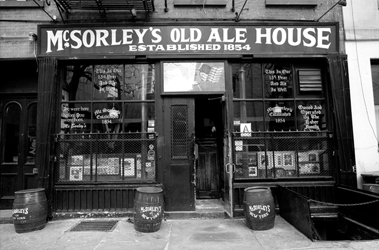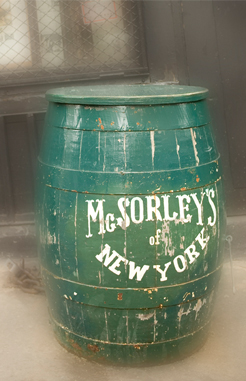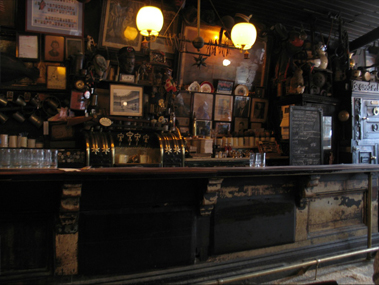McSorley's: The Old House at Home
“Light or dark?” That ‘tis the question McSorley’s Old Ale House patrons have faced for almost 160 years. Their choice earned them a mug of ale and the chance to experience a bit of New York’s past.
Now pull up a stool and hear this…

The Old House at Home
It nearly sounds as if it was after a couple of glasses of his own ale – that John McSorley named and opened “The Old House at Home,” in 1854. The aforementioned moniker was the original name of the alehouse that has survived to date; just a century and a half of ‘hailing the light and dark’ menu.
The tavern was originally situated on the ground level in the eastern half of a building or “taxpayer structure,” courtesy of real estate prospector John W. Mitchell. The bar’s original address was 15 ½ 7th Street, with an upholsterer operating next door.
The tavern features a walnut bar dating back to 1823. John McSorley salvaged it from a saloon torn down during the construction of Cooper Union. McSorley’s expanded during the following years, taking over the entire first floor in 1865. By then, the building had been augmented into a five-story tenement. Two iron pillars were erected inside the tavern to support the structure.
Pine sawdust was sprinkled about and would cover the floor of the bar – a tradition started in the early years to soak up drips and drops and spills, and one which carries on to date. Armchairs and wooden tables surrounded a big belly stove that warmed the front room.
A back room hosted more tables and a kitchen in the corner that served up a free lunch and a snack of raw onions, cheese and soda crackers – wasabi peas were the rumored runners-up. Posters, newspaper articles and other memorabilia cover every inch of the walls.

The Old House at Home stuck until a 1908 storm knocked down the sign. It was replaced with another that read McSorley’s Old Time Ale House. The word “Time” was later removed.
Being around the corner from Cooper Union, - established in 1859 as a tuition-free institution focused on adult education for men and women – McSorley’s was the best extracurricular in the neighborhood. The popularity of the alehouse is often attributed to its proximity to the college and accessibility to thirsty students – no evidence has been found to date however, as to how the upholsterer’s business was impacted from having students nearby.
Peter Cooper himself even became one of the more frequent patrons in the early days. His portrait occupies a prominent place on the walls of the tavern, drawing more than a few Cooper Union alumni over the years.
McSorley’s “Light or Dark” Cream Stock Ale
Only two beer options have been available for as long as most patrons can remember: light or dark ale, originally served in pewter and earthenware mugs.
John McSorley contracted the Harmon Brewery upon first opening. The Koehler brothers purchased Harmon in 1861 – and after a profound marketing meeting, they deemed the place the Koehler Brewery…until renaming it Fidelio in the 1880s.
The ale was made by Fidelio and in Manhattan until Prohibition forced them to close. By then, John’s son Bill was in charge and he wasn’t about to allow pesky federal legislators to get in the way of quenching New York City’s thirst for good beer. Two brew-masters, Barney Kelly and Ed Harrigan worked in the alehouse basement. The product was much stronger than the original so Bill McSorley cut it with a legal and low-alcohol brew called “near beer” and served it in the back room – and while crowd noise was kept at a low, Bill carried his father’s torch and continued a tradition of Toasting The Town.
Fidelio re-opened after Prohibition and picked up where they left off. In the 1940s, the brewery lost the McSorley’s contract to Brooklyn’s Rheingold Brewery. Schmidt’s Brewery of Philadelphia purchased Rheingold 30 years later, moving the brewing outside of New York. NY State’s water defined the McSorley’s flavor and without it the original flavor was never truly replicated.
The contract changed hands thrice more, going to Wisconsin-based Heileman Brewery in the 1990s, then the Stroh Brewery of Detroit, and finally California’s Pabst Brewing in 2000. The recipe has varied a little from brewery to brewery but it’s been kept a secret; still served today, in 8-ounce glass steins.
Memories on the Walls

John McSorley had a penchant for memorabilia, one that Bill McSorley protected, even nailing down posters, pictures and other items his father had only loosely hung on the walls.
The collection is vast; including a set of Civil War-era shackles and historic newspaper articles, including an original story about Lincoln’s assassination. Arguably, however, the most interesting piece hangs above the bar. The story goes back to World War I when young men met at McSorley’s before heading to war. They started a tradition, hanging wishbones on the rods of a gas lamp above the walnut bar. Those who returned reclaimed their wishbones but many remain.
The gas lamp is regarded as sacred. Bartenders refused to dust it for decades and it is known as a filthy but endearing fixture.
A Fraternity of Owners
The tavern stayed in the McSorley family until 1936 when Bill McSorley sold to Daniel O’Connell, a retired NYPD officer and devoted McSorley’s regular. He ran the alehouse for three years before passing away and leaving it to his daughter, Dorothy O’Connell Kirwan.
Even then, women were not permitted in McSorley’s and the new owner respected the rule. She would not enter the tavern during operating hours. A district court would later order McSorley’s to change their ways and the first women were served in August of 1970. (A women’s bathroom wasn’t added for another 16 years.)
Dorothy’s son Danny Kirwan inherited the bar in 1975. Two years later, he sold the bar to Matthew Maher, an Irish immigrant who’d come to New York City with the promise of a job at McSorley’sas far back as 1964 – then again, who needs a job when you can straight up own the place!
Maher still runs the alehouse today.
Today …
The armchairs are gone (except Peter Cooper’s which still stands behind the bar), yet the walnut bar remains in-tact and even extended a bit from its original length. Other than that, it’s thought that the bar looks similar to how it would have in 1865, after expanding into the entire first floor.
Doors now open at 11am (1pm on Sundays) and the crowds follow, often growing to standing room only and sometimes up to three layers deep at the bar. The kitchen still serves those raw onion, cheese and soda cracker snacks. Many who enter still feel the spirit of the mid 19th century alive and well in the oldest, continually operating Irish tavern in New York City.
Here’s to You
Special toast to Bill Wander; Official McSorley's Historian - we owe you a beer for your time good sir.
Confetti:
ARTICHOKE BASILLE’S PIZZA – Can’t tell light from dark ale anymore? Getting hungry? March up 2nd Avenue seven lucky blocks and fall in love with a slice or two from Artichoke Pizza. When deciding on what to order, don’t miss out on the obvious choice – or as a good friend once put it “Artichoke of course!” 328 East 14th Street (2nd Ave), East Village. (212) 228-2004
VELVET CIGARS – Owen Wilson & Christopher Walken (Wedding Crashers) aren’t the only guys who love sneaking away for stogies – if you love ‘em also, then cross over 2nd Avenue to Velvet Cigars. You can BYO_...Find friendly banter in an inward facing circle of armchairs…Just look cool holding their house and handcrafted line. 80 East 7th Street (2nd Ave), East Village (212) 533-5582.











